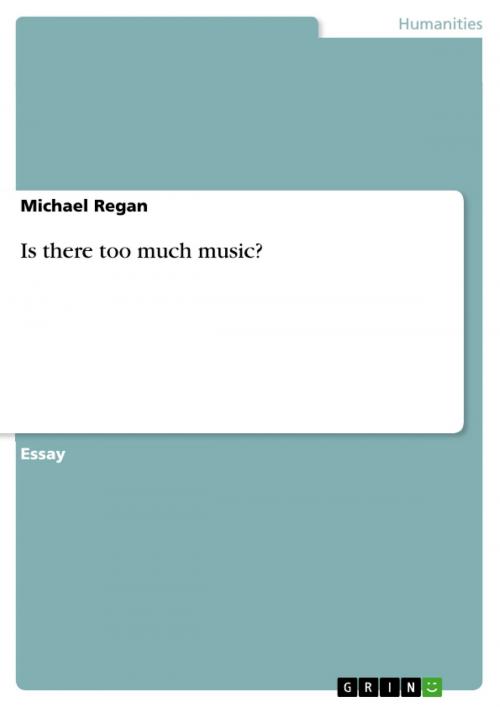Is there too much music?
Nonfiction, Social & Cultural Studies, Social Science, Cultural Studies, Popular Culture| Author: | Michael Regan | ISBN: | 9783656215929 |
| Publisher: | GRIN Publishing | Publication: | June 13, 2012 |
| Imprint: | GRIN Publishing | Language: | English |
| Author: | Michael Regan |
| ISBN: | 9783656215929 |
| Publisher: | GRIN Publishing |
| Publication: | June 13, 2012 |
| Imprint: | GRIN Publishing |
| Language: | English |
Essay from the year 2012 in the subject Sociology - Media, Art, Music, , language: English, abstract: Music, in all its multifarious styles and idioms, is everywhere, 24 hours a day. It never rests, and we can hear just about everything of significance ever composed, performed and improvised, at the touch of a button, on recordings and on the radio. If we live in or near a large town or city, we can attend a concert (or two) every day of our lives if we have the inclination. In this brief investigation into the effects of all this I will be concentrating on classical- or 'serious' music, but the same points made here could be made of popular music, jazz and 'world' music -they are all continuously available on the air, on disc, on line and in 'live' performance. Thus, regarding classical music, we may perceive several differing, and sometimes opposed effects of its proliferation and availability. On the positive side, we are now in the situation where we can get to know very much more than our predecessors. Next to nothing is now out of our reach, whether it be some obscure Medieval motet, a 19th century piano piece by a forgotten minor composer, or the very latest work by a composer living and working in say, Lithuania or some equally remote region. All the great masterpieces of the past five or more centuries are regularly performed, or failing that, recorded, often numerous times. Works of lesser stature by minor composers continue to be rescued from oblivion and given their chance on disc and in the concert hall. In addition to this a steady stream of new music by composers from all six inhabited continents is performed and recorded.
Essay from the year 2012 in the subject Sociology - Media, Art, Music, , language: English, abstract: Music, in all its multifarious styles and idioms, is everywhere, 24 hours a day. It never rests, and we can hear just about everything of significance ever composed, performed and improvised, at the touch of a button, on recordings and on the radio. If we live in or near a large town or city, we can attend a concert (or two) every day of our lives if we have the inclination. In this brief investigation into the effects of all this I will be concentrating on classical- or 'serious' music, but the same points made here could be made of popular music, jazz and 'world' music -they are all continuously available on the air, on disc, on line and in 'live' performance. Thus, regarding classical music, we may perceive several differing, and sometimes opposed effects of its proliferation and availability. On the positive side, we are now in the situation where we can get to know very much more than our predecessors. Next to nothing is now out of our reach, whether it be some obscure Medieval motet, a 19th century piano piece by a forgotten minor composer, or the very latest work by a composer living and working in say, Lithuania or some equally remote region. All the great masterpieces of the past five or more centuries are regularly performed, or failing that, recorded, often numerous times. Works of lesser stature by minor composers continue to be rescued from oblivion and given their chance on disc and in the concert hall. In addition to this a steady stream of new music by composers from all six inhabited continents is performed and recorded.















